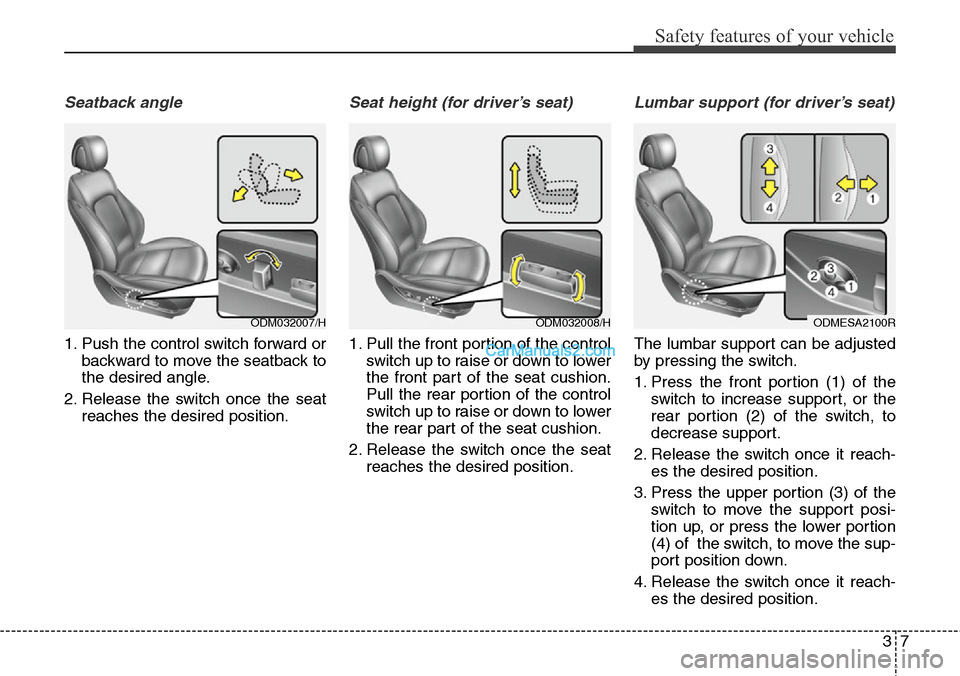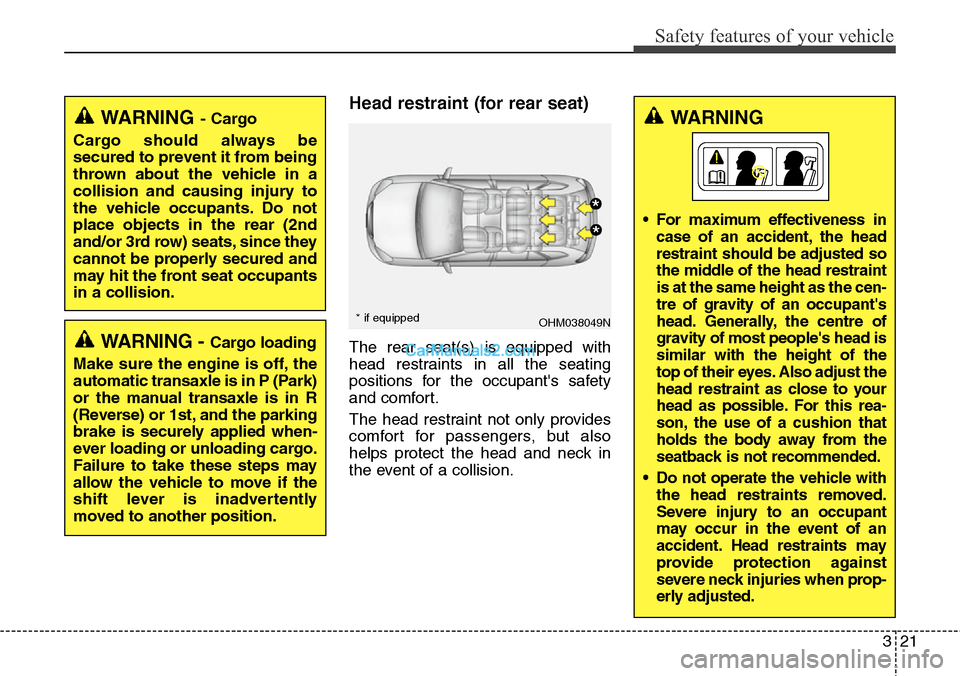Page 22 of 699
Safety features of your vehicle
2 3
Front seat
(1) Forward and backward
(2) Seatback angle
(3) Seat cushion height (Driver’s seat)
(4) Lumbar support (Driver’s seat)*
(5) Seat warmer* /
Seat cooler (air ventilation seat)*
(6) Head restraint
2nd row seat
(7) Forward and backward
(8) Seatback angle and folding
(9) Walk-in seat lever*
(10) Head restraint
(11) Armrest
(12) Seat warmer*
3rd row seat*
(13) Seatback folding
(14) Head restraint
* if equipped
SEATS
ODMESA2001R
Manual seat
Power seat
Page 25 of 699

35
Safety features of your vehicle
Seatback angle
To recline the seatback:
1. Lean forward slightly and lift up on
the seatback recline lever located
on the outside of the seat at the
rear.
2. Carefully lean back on the seat
and adjust the seatback of the
seat to the position you desire.
3. Release the lever and make sure
the seatback is locked in place.
(The lever MUST return to its orig-
inal position for the seatback to
lock.)
Seat cushion height
(for driver’s seat, if equipped)
To change the height of the seat
cushion, push the lever that is locat-
ed on the outside of the seat cushion
upwards or downwards.
• To lower the seat cushion, push
down the lever several times.
• To raise the seat cushion, pull up
the lever several times.
Lumbar support
(for driver’s seat, if equipped)
The lumbar support can be adjusted
by pressing the lumbar support
switch on the side of the seat.
1. Press the front portion of the
switch to increase support, or the
rear portion of the switch, to
decrease support.
2. Release the switch once it reach-
es the desired position.
ODM032003/HODM032004/HODM032005/H
Page 27 of 699

37
Safety features of your vehicle
Seatback angle
1. Push the control switch forward or
backward to move the seatback to
the desired angle.
2. Release the switch once the seat
reaches the desired position.
Seat height (for driver’s seat)
1. Pull the front portion of the control
switch up to raise or down to lower
the front part of the seat cushion.
Pull the rear portion of the control
switch up to raise or down to lower
the rear part of the seat cushion.
2. Release the switch once the seat
reaches the desired position.
Lumbar support (for driver’s seat)
The lumbar support can be adjusted
by pressing the switch.
1. Press the front portion (1) of the
switch to increase support, or the
rear portion (2) of the switch, to
decrease support.
2. Release the switch once it reach-
es the desired position.
3. Press the upper portion (3) of the
switch to move the support posi-
tion up, or press the lower portion
(4) of the switch, to move the sup-
port position down.
4. Release the switch once it reach-
es the desired position.
ODM032007/HODM032008/HODMESA2100R
Page 29 of 699

39
Safety features of your vehicle
Easy access function
(if equipped)
The system will move the driver's
seat automatically as follows:
• Without smart key system
- It will move the driver’s seat rear-
ward when the ignition key is
removed and front driver’s door is
opened.
- It will move the driver’s seat for-
ward when the ignition key is
inserted.
• With smart key system
- It will move the driver’s seat rear-
ward when the engine start/stop
button is changed to the OFF
position and front driver’s door is
opened.
- It will move the driver’s seat for-
ward when the engine start/stop
button is changed to the ACC or
START position.
You can activate or deactivate this
feature. Refer to "User settings" in
section 4.
Head restraint (for front seat)
The driver's and front passenger's
seats are equipped with a head
restraint for the occupant's safety and
comfort.
The head restraint not only provides
comfort for the driver and front pas-
senger, but also helps to protect the
head and neck in the event of a colli-
sion.
OHM038048N
WARNING
• For maximum effectiveness in
case of an accident, the head
restraint should be adjusted so
the middle of the head restraint
is at the same height as the
centre of gravity of an occu-
pant's head. Generally, the cen-
tre of gravity of most people's
head is similar with the height
of the top of their eyes. Also,
adjust the head restraint as
close to your head as possible.
For this reason, the use of a
cushion that holds the body
away from the seatback is not
recommended.
• Do not operate the vehicle with
the head restraints removed as
severe injury to the occupants
may occur in the event of an
accident. Head restraints may
provide protection against neck
injuries when properly adjust-
ed.
• Do not adjust the head restraint
position of the driver's seat
whilst the vehicle is in motion.
Page 30 of 699
Safety features of your vehicle
10 3
Forward and backward adjustment
(if equipped)
The head restraint may be adjusted
forward to 4 different positions by
pulling the head restraint forward to
the desired detent. To adjust the
head restraint to it’s furthest back-
wards position, pull it fully forward to
the farthest position and release it.
Adjust the head restraint so that it
properly supports the head and
neck.
Adjusting the height up and down
To raise the head restraint :
1. Pull it up to the desired position (1).
To lower the head restraint :
1. Push and hold the release button
(2) on the head restraint support.
2. Lower the head restraint to the
desired position (3).ODM032011
ODM032010
OYFH034205
CAUTION
If you recline the seatback
towards the front with the head
restraint and seat cushion
raised, the head restraint may
come in contact with the sunvi-
sor or other parts of the vehicle.
Page 32 of 699
Safety features of your vehicle
12 3
3. Adjust the head restraint to the
appropriate height.Seat warmer (if equipped)
ODMESA2010R
ODMESA2012R
■Type A
■Type BODMESA2011R
ODMESA2013R
■Type C
■Type D
The seat warmer is provided to warm the front seats during cold weather.
With the ignition switch in the ON position, push either of the switches to
warm the driver's seat or the front passenger's seat.
During mild weather or under conditions where the operation of the seat
warmer is not needed, keep the switches in the "OFF" position.
WARNING
Always make sure the head
restraint locks into position
after reinstalling and adjusting
it properly.
Page 41 of 699

321
Safety features of your vehicle
Head restraint (for rear seat)
The rear seat(s) is equipped with
head restraints in all the seating
positions for the occupant's safety
and comfort.
The head restraint not only provides
comfort for passengers, but also
helps protect the head and neck in
the event of a collision.
WARNING- Cargo
Cargo should always be
secured to prevent it from being
thrown about the vehicle in a
collision and causing injury to
the vehicle occupants. Do not
place objects in the rear (2nd
and/or 3rd row) seats, since they
cannot be properly secured and
may hit the front seat occupants
in a collision.
WARNING - Cargo loading
Make sure the engine is off, the
automatic transaxle is in P (Park)
or the manual transaxle is in R
(Reverse) or 1st, and the parking
brake is securely applied when-
ever loading or unloading cargo.
Failure to take these steps may
allow the vehicle to move if the
shift lever is inadvertently
moved to another position.
OHM038049N
*
*
* if equipped
WARNING
• For maximum effectiveness in
case of an accident, the head
restraint should be adjusted so
the middle of the head restraint
is at the same height as the cen-
tre of gravity of an occupant's
head. Generally, the centre of
gravity of most people's head is
similar with the height of the
top of their eyes. Also adjust the
head restraint as close to your
head as possible. For this rea-
son, the use of a cushion that
holds the body away from the
seatback is not recommended.
• Do not operate the vehicle with
the head restraints removed.
Severe injury to an occupant
may occur in the event of an
accident. Head restraints may
provide protection against
severe neck injuries when prop-
erly adjusted.
Page 42 of 699
Safety features of your vehicle
22 3
Adjusting the height up and down
To raise the head restraint :
1. Pull it up to the desired position (1).
To lower the head restraint :
1. Push and hold the release button
(2) on the head restraint support
2. Lower the head restraint to the
desired position (3).
Removal and installation
To remove the head restraint :
1. Raise it as far as it can go.
2. Press the release button (1) whilst
pulling upward (2).
To reinstall the head restraint :
1. Put the head restraint poles (3)
into the holes whilst pressing the
release button (1).
2. Adjust the head restraint to the
appropriate height.
ODM032023ODM032024
CAUTION
When there is no occupant in
the rear seats, adjust the height
of the head restraint to the low-
est position. The rear seat head
restraint can reduce the visibili-
ty of the rear area.